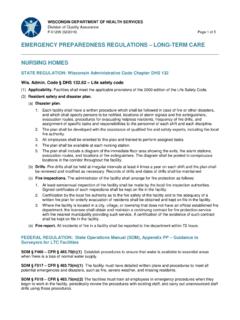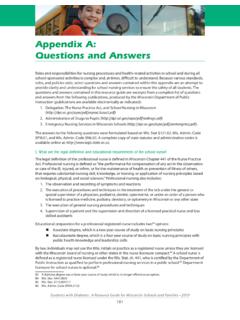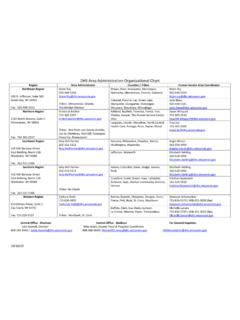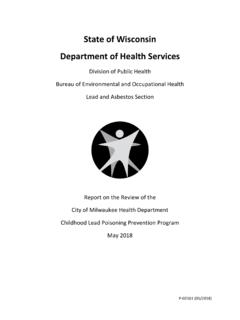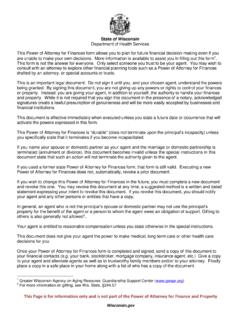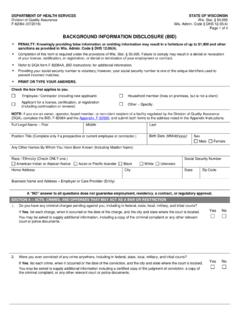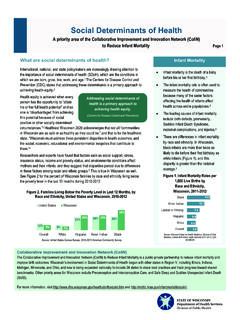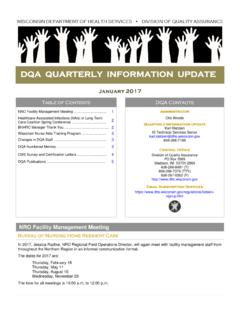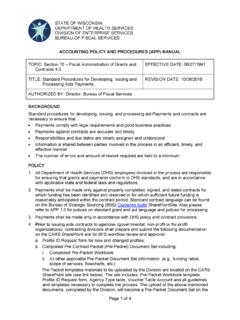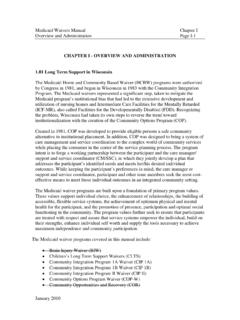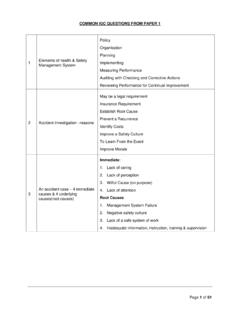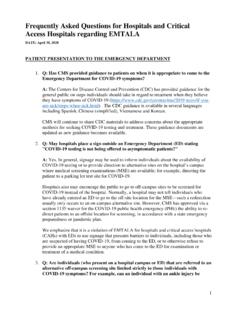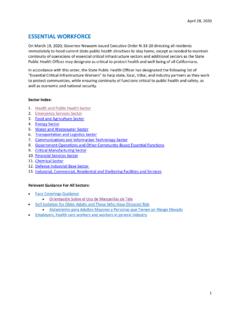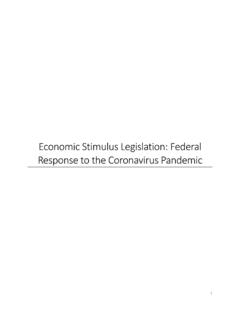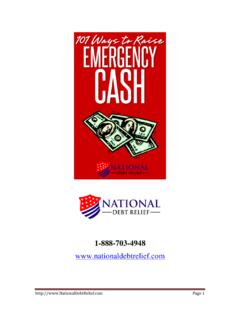Transcription of PREVENTING & MANAGING COVID-19 OUTBREAKS IN THE …
1 PREVENTINGMANAGINGGUIDANCE FOR EMPLOYERSIN NON-HEALTH CARE ANDNON-EDUCATIONAL SETTINGSCOVID-19 OUTBREAKS IN THE WORKPLACEP-02787 (1/2022)Summary of Changes (01/2021) The audience for this guidance has been clarified and links provided to separate guidance for health care and educational settings (page 1). Quarantine guidance has been updated to include new shortened quarantine period options released by CDC and endorsed by DHS. A shortened quarantine of 7 or 10 days is permissible if certain criteria are met. A 14-day quarantine remains the recommended option and use of abbreviated quarantine is at the discretion of local and tribal health departments (page 9). Serial testing is no longer a recommended strategy for non-health care settings (page 12). Information on the use and reliability of antigen tests has been included along with links to relevant testing guidance from CDC (page 11)Summary of Changes (05/2021) Guidance on COVID-19 testing of fully vaccinated workers has been updated (page 10).
2 Quarantine guidance has been updated to include quarantine after vaccination (pages 14-15). Summary of Changes (09/2021) Standard epidemiologic terms and protocol consolidated and moved to front of document. Quarantine and isolation timelines reformatted. Information on booster doses, as it applies to definitions of full vaccination, is of Changes (01/2022) Revised quarantine and isolation recommendations based on updated CDC guidanceSummary of Changes (10/2021) Clarified recommendations about testing. (pages 5, 14, and 15) Updated resources page to include links to OSHA guidance on the National Emphasis Program. (page 19) Numerous updates throughout to simplify of ContentsIntroduction ..1 Workplace Outbreak Checklist ..2 How to keep my business running and workers and customers safe ..3 Make a COVID-19 plan for your business ..3Is the workplace safe? ..4 Workplace risk assessment.
3 4 Worker training ..4 Worker screening ..5 First steps when a worker tests positive for COVID-19 ..6 Working with the local and tribal health department ..8 When to call the LTHD ..8 What Is contact tracing? ..8 Who Is a close contact? .. 8 Working with the LTHD during the outbreak investigation ..9 What s an outbreak and what s an outbreak investigation? ..9 How can I, the employer, assist the LTHD during an outbreak investigation? ..9 COVID-19 testing ..10 When should workers get tested? ..10 Types of COVID-19 tests ..11A note about diagnostic tests ..11 Tier 1: testing close contacts ..12 Tier 2: testing all workers in a unit or section ..12 Tier 3: testing all workers in a facility ..12 Taking action following testing ..12 When can workers return? ..13 Return to work guidelines ..13 After release from isolation or quarantine ..14 Business outbreak scenario ..15 Quarantine guidance for close contacts with no symptoms.
4 15 Starting a COVID-19 testing program for my business ..16 Specimen collection ..16 Lab processing ..16 Patient notification ..16 Reporting worker test results to public health as an employer ..17 Resources ..18 Appendices ..20 Wisconsin Department of Health Services1 The guidance in this document answers these questions and includes resources to keep you informed and prepare you for working with the LTHD . This guidance also offers resources from the Wisconsin Economic Development Corporation (WEDC) and the Wisconsin State Laboratory of Hygiene (WisCon) to maximize safety in the workplace. Although working with the LTHD is required in state statutes, this document focuses on best practices and a collaborative approach with public health that is needed to stop the spread of COVID-19 . Introduction1 How do we keep workers and customers safe while ensuring continued business operation?2 What are the first action items when a worker tests positive for COVID-19 ?
5 3 What can you expect when working with the LTHD during an investigation?4 How should COVID-19 testing be utilized in the workplace?5 When can a worker return?SARSCoV-2 SARSCoV-2 SARSCoV-2 When a worker tests positive for COVID-19 , there are important questions you will need to address: SARSCoV-2 SARSCoV-2 This document assists employers when a worker tests positive for COVID-19 . It describes how to work with local and tribal health departments (LTHDs) to help keep workers and customers healthy and keep businesses running smoothly during the pandemic. Please note that this guidance document is meant for non-health care and non-educational settings. Wisconsin DHS has separate guidance for health care and educational settings. Wisconsin Department of Health Services2 Workplace Outbreak ChecklistStepsResourcesEncourage employees to get vaccinated against First steps when a worker tests positive for COVID-19 , page 53.
6 Make a COVID-19 Make a COVID-19 plan for the workplace , page 3; fill out Appendix A; contact WisCon with any questions and/or use their planning local and tribal health department (LTHD) contacts. See First steps when a worker tests positive for COVID-19 , page 5, #4. Get a free workplace risk Workplace risk assessment, page 4; contact a worker and customer COVID-19 screening Worker screening, page 5; see Appendix B. When a worker tests positive for COVID-19 Take first steps to reduce COVID-19 spread in the First steps when a worker tests positive for COVID-19 , page 5, #1-5; see Appendix A and Appendix C. During the outbreak investigationIdentify and report information to the LTHD regarding the facility and affected workers. See Working with the local and tribal health department, page 8; see Appendix A and Appendix how contact tracing, isolation and quarantine Working with the local and tribal health department, page 8 Understand testing procedures and review testing strategies with the LTHD if COVID-19 testing, page 10 Arrange for a facility risk Workplace risk assessment, page 4; contact WisConUnderstand when workers can return after isolation or When can workers return?
7 , page 13 When the outbreak investigation endsReview closeout letter and any risk assessment guidance Department of Health Services3 Encourage employee vaccinationCOVID-19 vaccines are safe, effective, free, and widely available. Here are some ways you can promote vaccination among your employees: Encourage workers to get vaccinated. Workers should also be encouraged to receive booster doses when eligible. Provide paid time off for workers to get the vaccine and recover from any side effects. Host an onsite vaccination clinic for workers and their families. Implement COVID-19 testing programs in the more information on vaccines including how and where to get vaccinated, please visit DHS vaccination website. WEDC s Vaccine Guidance for all Businesses offers additional guidance specific to workplace a COVID-19 plan for your business Make a COVID-19 plan for the workplace, with safety as the top priority.
8 The Wisconsin State Laboratory of Hygiene s WisCon program has a helpful template and can answer questions about making the plan or conduct a free on-site assessment to recommend environmental controls. Complete the checklist in Appendix A. Include daily screening of workers, regular cleaning and disinfection of workspaces, personal protective equipment (PPE) and physical distancing. Draft the plan before you need it. If a worker tests positive for COVID-19 , a plan is essential to moving your business forward and enabling proactive, rather than reactive, to keep my business running and workers and customers safe Learn how the plan s basic steps work: contact tracing (see What is contact tracing?, page 8), isolation and quarantine (see When can workers return?, page 13). Consider reviewing and revising paid leave, paid time off (PTO) and other policies, as needed: Direct workers to stay home when they re ill or subject to quarantine (see page 13).
9 If the worker has exhausted paid sick time and PTO is not an option, offer unpaid time off or create a policy to offer PTO specifically for COVID-19 . Consider suspending no-fault attendance policies. Let workers know that they won t be terminated if they have to isolate or quarantine for themselves or care for an isolated or quarantined family Department of Health Services4 Workplace risk assessment A risk assessment is key to stopping COVID-19 in workplaces. How well is a workplace prepared to keep workers and visitors safe from COVID-19 ? is the most critical question to consider. This question can be answered by a workplace risk assessment from experienced public health professionals. After a risk assessment, you will understand what needs to be done in the workplace to stop COVID-19 . Free professional help is available. WisCon is a free, professional consulting service that offers risk assessment services to businesses during COVID-19 .
10 Note: WisCon s COVID-19 services are not connected to a regulatory inspection or reported to the Occupational Safety and Health Administration (OSHA). WisCon can be contacted at 608-226-5246 or by email at or you can request assistance on the WisCon website. Sharing the final report with the LTHD is recommended. Is the workplace safe?Worker trainingWorkers should be trained on best practices to keep themselves, their families and those around them safe and healthy. When selecting or organizing a training program, it is important to consider all literacy and education levels and native languages in the workforce. These trainings can come in the form of webinars, prerecorded videos or in-person training. Providing a safe space, the necessary resources and paid time for the training will be essential elements for full worker participation and engagement. Handing out a pamphlet with guidance is unlikely to be seen as sufficient in case of an OSHA investigation.
